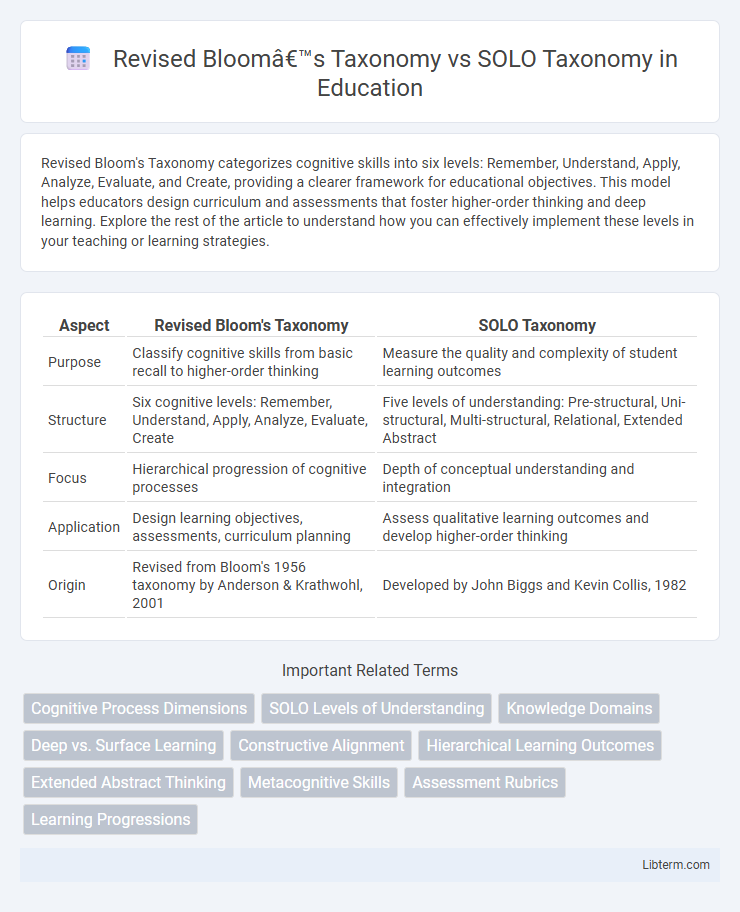Revised Bloom's Taxonomy categorizes cognitive skills into six levels: Remember, Understand, Apply, Analyze, Evaluate, and Create, providing a clearer framework for educational objectives. This model helps educators design curriculum and assessments that foster higher-order thinking and deep learning. Explore the rest of the article to understand how you can effectively implement these levels in your teaching or learning strategies.
Table of Comparison
| Aspect | Revised Bloom's Taxonomy | SOLO Taxonomy |
|---|---|---|
| Purpose | Classify cognitive skills from basic recall to higher-order thinking | Measure the quality and complexity of student learning outcomes |
| Structure | Six cognitive levels: Remember, Understand, Apply, Analyze, Evaluate, Create | Five levels of understanding: Pre-structural, Uni-structural, Multi-structural, Relational, Extended Abstract |
| Focus | Hierarchical progression of cognitive processes | Depth of conceptual understanding and integration |
| Application | Design learning objectives, assessments, curriculum planning | Assess qualitative learning outcomes and develop higher-order thinking |
| Origin | Revised from Bloom's 1956 taxonomy by Anderson & Krathwohl, 2001 | Developed by John Biggs and Kevin Collis, 1982 |
Introduction to Educational Taxonomies
Revised Bloom's Taxonomy categorizes cognitive skills into six hierarchical levels, emphasizing knowledge acquisition, comprehension, application, analysis, synthesis, and evaluation to structure learning objectives. SOLO Taxonomy measures the quality of student responses through five levels, from pre-structural understanding to extended abstract reasoning, highlighting depth of comprehension and complexity. Both frameworks provide educators with tools to design, assess, and enhance learning experiences, aligning instructional goals with cognitive development stages.
Overview of Revised Bloom’s Taxonomy
Revised Bloom's Taxonomy categorizes cognitive skills into six hierarchical levels: Remembering, Understanding, Applying, Analyzing, Evaluating, and Creating, emphasizing active verbs for measurable learning outcomes. It integrates a knowledge dimension distinguishing factual, conceptual, procedural, and metacognitive knowledge, enhancing curriculum design and assessment strategies. The taxonomy's dynamic framework supports educators in developing learning objectives that promote critical thinking and deeper comprehension.
Breakdown of SOLO Taxonomy
SOLO Taxonomy categorizes learning outcomes into five levels: Pre-structural, Unistructural, Multistructural, Relational, and Extended Abstract, each representing increasing cognitive complexity. It breaks down student understanding from grasping isolated facts (Pre-structural and Unistructural) to integrating multiple pieces of information (Multistructural), connecting ideas coherently (Relational), and generating novel insights or abstractions (Extended Abstract). This hierarchical structure contrasts with Revised Bloom's Taxonomy, which emphasizes cognitive processes like remembering, understanding, and creating within a two-dimensional framework of knowledge and skills.
Structural Differences Between Both Taxonomies
Revised Bloom's Taxonomy categorizes cognitive skills into six hierarchical levels: Remembering, Understanding, Applying, Analyzing, Evaluating, and Creating, emphasizing a progression from lower- to higher-order thinking skills. SOLO Taxonomy structures learning outcomes through five levels of increasing complexity: Pre-structural, Uni-structural, Multi-structural, Relational, and Extended Abstract, highlighting the depth and integration of learner understanding. While Revised Bloom's organizes tasks by cognitive processes, SOLO focuses on the quality of student responses and conceptual understanding, reflecting a fundamental structural difference in their educational frameworks.
Key Similarities in Learning Progression
Revised Bloom's Taxonomy and SOLO Taxonomy both emphasize structured learning progression through hierarchical levels of cognitive complexity, fostering deeper understanding and skill development. Each taxonomy categorizes learning objectives, with Revised Bloom's focusing on cognitive processes such as remembering, understanding, and creating, while SOLO Taxonomy describes levels of increasing structural complexity from unistructural to extended abstract. Both frameworks support educators in designing curriculum and assessments that promote incremental mastery and meaningful knowledge construction.
Contrasting Cognitive Processes
Revised Bloom's Taxonomy categorizes cognitive processes into six hierarchical levels: Remember, Understand, Apply, Analyze, Evaluate, and Create, emphasizing progressively complex thinking skills. In contrast, SOLO Taxonomy focuses on the quality of learning outcomes by categorizing responses into five levels: Pre-structural, Uni-structural, Multi-structural, Relational, and Extended Abstract, highlighting the depth of understanding. While Revised Bloom's stresses cognitive action verbs, SOLO assesses comprehension growth from surface to deep integration, making each framework suited to different educational assessment goals.
Application in Classroom Assessment
Revised Bloom's Taxonomy emphasizes the cognitive process of applying knowledge through tasks such as problem-solving and implementing concepts in varied contexts, making it highly effective for designing classroom assessments that measure students' ability to use learned material. SOLO Taxonomy assesses the quality and complexity of student responses by categorizing understanding into levels, from pre-structural to extended abstract, which helps educators evaluate the depth of student learning and scaffold assessment tasks accordingly. Incorporating both taxonomies in classroom assessment enables a comprehensive evaluation of not only the application but also the progression and integration of student understanding.
Strengths and Weaknesses Comparison
Revised Bloom's Taxonomy excels in providing a clear hierarchical framework for categorizing cognitive skills from remembering to creating, facilitating curriculum design and assessment alignment. SOLO Taxonomy offers a distinctive advantage in assessing the quality of students' responses through levels of understanding, ranging from surface (prestructural) to deep (extended abstract) learning, promoting a nuanced evaluation of comprehension. However, Revised Bloom's Taxonomy can be overly linear and less effective in capturing integrated knowledge structures, while SOLO Taxonomy may require more extensive training to apply consistently and can be less intuitive for educators unfamiliar with its multi-level approach.
Choosing the Right Taxonomy for Curriculum Design
Revised Bloom's Taxonomy emphasizes cognitive processes like remembering, understanding, applying, analyzing, evaluating, and creating, making it ideal for designing clear, hierarchical learning objectives. SOLO Taxonomy focuses on the quality of students' responses, progressing from unistructural to extended abstract levels, which supports deepening conceptual understanding and assessment of complexity. Selecting the right taxonomy depends on curriculum goals: use Bloom's for structuring knowledge acquisition and SOLO for evaluating conceptual depth and cognitive complexity in student learning.
Implications for Future Educational Practice
Revised Bloom's Taxonomy emphasizes cognitive process dimensions and knowledge types to enhance curriculum design and assessment strategies, promoting deeper student understanding and critical thinking skills. SOLO Taxonomy categorizes learning outcomes based on increasing levels of complexity, facilitating clearer differentiation in student performance and targeted instructional interventions. Integrating both frameworks can lead to more comprehensive educational practices by aligning detailed cognitive processes with complexity-based learning progressions, improving personalized learning and assessment accuracy.
Revised Bloom’s Taxonomy Infographic

 libterm.com
libterm.com